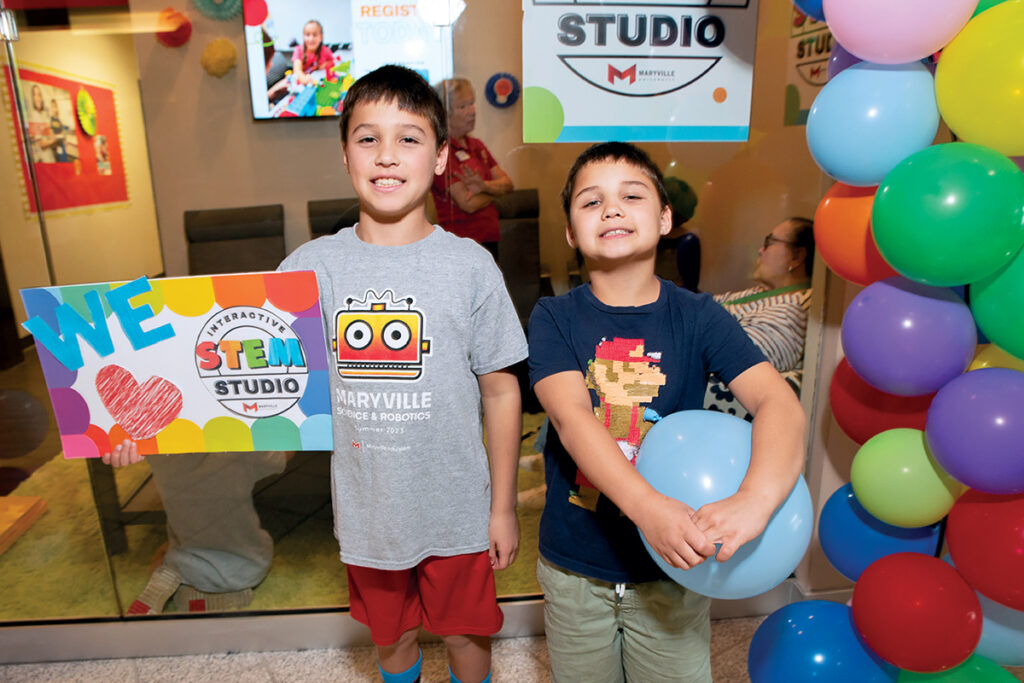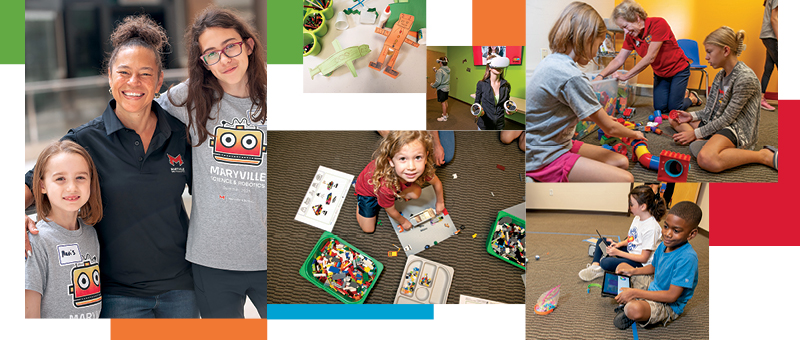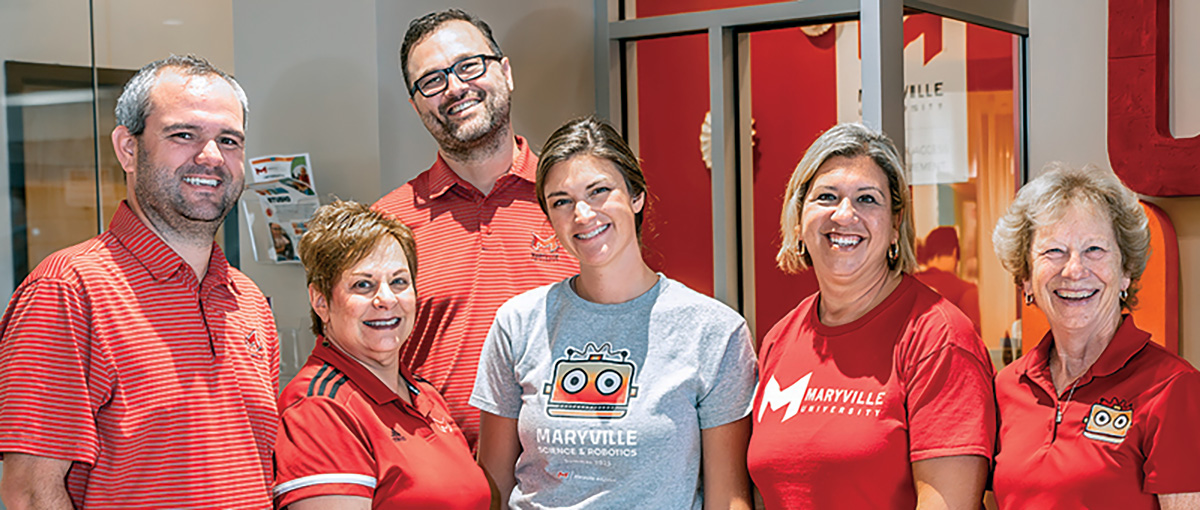Maryville’s CA2 program expands into brick-and-mortar space, readying young minds for an open-ended future.
Inside a space once known for dozens of retail stores and a robust food court, Maryville is helping St. Louis-area kids gear up for future careers. In September, the University opened its Interactive STEM Studio inside the reimagined Chesterfield Mall, not far from Maryville’s campus. The pop-up space next to The Cheesecake Factory is stuffed with LEGOs, robots, drones and other supplies where kids ages 4 to 16 hone their creativity along with their science, technology, engineering and math skills.
The project demonstrates the University’s mission to be a force for good in the community, according to Steve Coxon, professor and executive director of Maryville’s Center for Access and Achievement (CA2). “We’re very excited,” Coxon said. “We’re able to offer classes that are a really good value with phenomenal teachers and provide a lot of access for kids around Maryville’s campus.”

MOVING FAST ON GOOD IDEAS
The STEM Studio’s inaugural session includes more than a dozen evening and Saturday classes, with offerings for home- schoolers during the school day. A combined 200 kids are taking advantage of the studio’s offerings for a fee of $90 for six once-a-week classes. The idea builds on Maryville’s popular summer robotics camps, which enrolled 1,100 kids this past summer. Coxon and Angelina Moehlmann, program director for the CA2 elementary school science and robotics program and the STEM Studio, wanted to serve more children and teens. They also aspired to make use of camp materials — including literally millions of LEGOs provided by a $250,000 grant from the toymaker — for longer than just three months a year. Moehlmann located the inexpensive mall space, and they pitched the idea to the administration.
“And we got a really, really quick approval,” Coxon said. “Maryville is all about moving fast on good ideas.” Coxon and Moehlmann worked with STEM Studio Associate Director Dustin Nadler, PhD, and Coordinator Gretchen Roberts to make their vision a reality. The process included a bit of dirty work as they cleaned up debris to make the dilapidated space habitable. “It was very hands-on,” Coxon said.
Keeping it hands-on is also a key component of the lab’s classes. In age- appropriate groups, young people learn to program robots and drones, create video games and virtual reality experiences, and build skyscrapers and bridges. It’s nothing like school — no tests, grades or red-pencil corrections, according to Moehlmann. “It’s loud and busy, student-driven and play-based,” she said. “You have a buy-in from the kids when learning happens through the actvities they’re doing rather than a teacher just doling out information.”
Even as they enjoy themselves, students are honing their problem-solving skills and spatial abilities while engaging in high-level processes, including design thinking and prototyping — all components of the modern workplace. “In a rapidly changing world, no one can predict what jobs will actually exist by the time these kids enter into their careers,” Moehlmann said. Still, no matter what the future looks like, understanding how to work with others will remain essential.
“What we’re doing gives them not just the hard skills but the soft skills, too — like collaboration and communication,” she said. Giving kids the chance to maximize communication is particularly important right now, according to Coxon. During the pandemic, many were isolated for as long as two years, losing out on opportunities to interact with others. STEM Studio classes are designed to meet each child where they are, taking into account differences in social skills, prior knowledge, learning styles and brain wiring. All in all, the lab provides high value at no cost to the University. Class fees and money collected from events such as birthday parties are used to pay teachers and meet other expenses.

SUCCEEDING “EXCEPTIONALLY”
STEM Studio instructor Tarren Fritz enjoyed a decadeslong career as an elementary school teacher. Fritz likes to teach STEM skills in combination with storytelling. When introducing younger kids to drones, she shows the children how to program them to perform simple tasks such as going forward or backward or making a square. Then, using LEGOs, they build a setting for a dramatic storyline. “It might be that there’s a forest fire and we need to rescue some horses,” Fritz said. “And then we’ll talk about the parameters of the fire and the limitations and constraints of the drone.”
Another of Fritz’s lessons marries classical art with math and engineering. Kids work to recreate a Picasso or Monet using LEGOs to form the shapes, colors and textures of the painting. Fritz loves the open-ended curriculum- planning that’s possible only in a non-school setting. “We’re not beholden to standards and we don’t have to meet any certain criteria,” Fritz said. “We based the classes on interest and ideas from the public.”
Teacher Matt Sinclair, ’23, enjoys seeing his students work the steps to meet a challenge such as creating a new video game level using Mario Maker design tools. “Their eyes light up and they might say, ‘Oh, I can really see myself getting into this and doing this when I’m older,’” Sinclair said. Sinclair enjoys encouraging kids to use their imagination as well as their intellect. In his Dungeons and Dragons class, students learn how to design effective dungeons and create memorable characters such as believable good guys and proper villains.
As a bonus, Sinclair likes helping kids take an interest in something that can assist them in making and keeping friends. “Gaming is a great way to socialize,” Sinclair said. “Like, maybe I don’t have a great excuse to hang out with my new coworker, but I know he plays Call of Duty and that’s something we can talk about.” Sinclair applauds the University for expanding its popular summer program into a year-round endeavor. “I feel like that’s a huge thing with Maryville,” Sinclair said. “It’s like, ‘Hey, we succeeded — now how can we succeed exceptionally?’”
As Coxon and Moehlmann look to the future, they envision a permanent, stand- alone space for the STEM Studio. They hope to set up a fund for scholarships. Moehlmann hopes to serve kids coming in for school field trips and Scouting excursions while also expanding their slate of regular classes. “Just as we ask kids to tinker and develop their ideas in our classes, that’s what we’re doing with our programming,” Moehlmann said.
NOTE: This article originally appeared in the Fall/Winter 2023 issue of Maryville Magazine.
